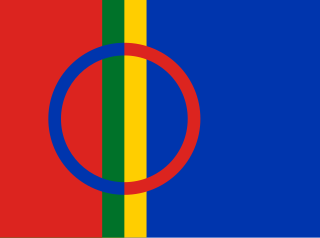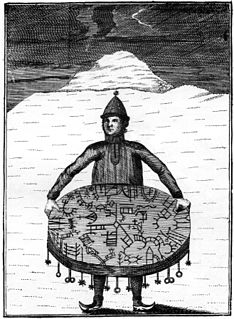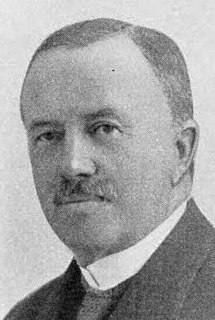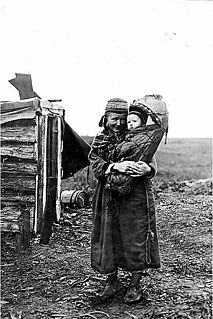
The Sámi people are a Finno-Ugric-speaking people inhabiting the region of Sápmi, which today encompasses large northern parts of Norway, Sweden, Finland, and of the Murmansk Oblast, Russia, most of the Kola Peninsula in particular. The Sámi have historically been known in English as Lapps or Laplanders, but these terms are regarded as offensive by the Sámi people, who prefer the area's name in their own languages, e.g. Northern Sámi Sápmi. Their traditional languages are the Sámi languages, which are classified as a branch of the Uralic language family.

Sápmi is the cultural region traditionally inhabited by the Sámi people. Sápmi is in Northern and Eastern Europe and includes the northern parts of Fennoscandia, also known as the "Cap of the North".

In traditional Sámi music songs and joiks are important musical expressions of the Sámi people and Sámi languages. The Sámi also use a variety of musical instruments, some unique to the Sámi, some traditional Scandinavian, and some modern introductions.
A joik or yoik is a traditional form of song in Sámi music performed by the Sámi people of Sapmi in Northern Europe. A performer of joik is called a joikaaja, a joiker or jojkare. Originally, joik referred to only one of several Sami singing styles, but in English the word is often used to refer to all types of traditional Sami singing. As an art form, each joik is meant to reflect or evoke a person, animal, or place..

Angelica is a genus of about 60 species of tall biennial and perennial herbs in the family Apiaceae, native to temperate and subarctic regions of the Northern Hemisphere, reaching as far north as Iceland, Lapland and Greenland. They grow to 1–3 m tall, with large bipinnate leaves and large compound umbels of white or greenish-white flowers. Found mainly in China, its main use was for medicine. It shows variations in fruit anatomy, leaf morphology and subterranean structures. The genes are extremely polymorphic.

Mari Boine is a Norwegian Sámi singer. She combined traditional Sámi joik singing with rock. In 2008, she became a professor of musicology at Nesna University College.

A noaidi is a shaman of the Sami people in the Nordic countries, playing a role in Sámi religious practices. Most noaidi practices died out during the 17th century, most likely because they resisted Christianization of the Sámi people and the king's authority. Their actions were referred to in courts as "magic" or "sorcery". Several Sámi shamanistic beliefs and practices are similar to those of some Siberian cultures.

Lavvu is a temporary dwelling used by the Sami people of northern extremes of Northern Europe. It has a design similar to a Native American tipi but is less vertical and more stable in high winds. It enables the indigenous cultures of the treeless plains of northern Scandinavia and the high arctic of Eurasia to follow their reindeer herds. It is still used as a temporary shelter by the Sami, and increasingly by other people for camping. It should not be confused with the goahti, another type of Sami dwelling, or the Finnish laavu.
Muitalægje was the first newspaper to publish in a Sámi language. Launched in April 1873 in Čáhcesuolu, Norway, the paper published a total of 33 issues before folding in September 1875. The full title of the paper was Muittalægje Čuvgetusa Haliduvvidi Sámi Gaskast.

The Museum of Ethnography, in Stockholm, Sweden, is a Swedish science museum. It houses a collection of about 220,000 items relating to the ethnography, or cultural anthropology, of peoples from around the world, including from China, Korea, South and Southeast Asia, the Pacific region, the Americas and Africa. The museum is situated in Museiparken at Gärdet in Stockholm. Since 1999, it is a part of Swedish National Museums of World Culture and is also hosting the Sven Hedin Foundation. The museum is open Tuesday to Sunday 11:00AM – 5:00 PM, and Wednesdays 11:00 AM – 8:00 PM and is closed on Mondays.

Arådalen is a valley immediately west of the mountain Hundshögen in southern Oviksfjällen, Oviken parish, Berg's Municipality, Jämtland, Sweden. It has been named after the watercourse Arån as from the valley is flowing southward.

Knut Hjalmar Stolpe, was a Swedish entomologist, archaeologist, and ethnographer. He was the first director and curator of the Museum of Ethnography, Sweden. He is best known for his meticulous archaeological excavations at the Viking-age site Birka on the island Björkö.

Halfdan Bryn was a Norwegian physician and physical anthropologist.

Emilie Demant Hatt was a Danish artist, writer, ethnographer, and folklorist. Her area of interest and expertise was the culture and way of life of Sámi people.

Sámi Americans are Americans of Sámi descent, who originate from Sapmi, the northern regions of Norway, Sweden, Finland, and the Kola Peninsula of Russia. The term Lapp Americans has been historically used, though lapp is considered derogatory by the Sámi. It has been estimated that there are 30,000 people of Sámi ancestry living in North America.

The forest Sami are Sami people who live in the woods and who, unlike the reindeer-herding Sami people, do not move up into the fells during the summer season. Historically, there have been forest Sami in Sweden in the area ranging from northern Ångermanland to the far north. In the early 1600s the term granlapp was also used to refer to the Sami people who paid taxes only to Sweden, compared to the semi-nomadic fell Sami, who, since they worked in the fells that straddled the Swedish-Norwegian border, had to pay taxes to both countries. When Ernst Manker studied the life of the forest Sami in the early 20th century, nearly all of their habitations had been abandoned. Only one forest Sami village remained, in Malå in Västerbotten, an area known as Stenundslandet in Anundsjö.

Ernst Mauritz Manker was a Swedish ethnographer, known for his work on Sami history and ethnography.
Swedification refers to the spread and/or imposition of the Swedish language, people and culture or policies which introduced these changes. In the context of Swedish expansion within Scandinavia, Swedification can refer to both the integration of Scania in the 1600s and governmental policies regarding Sámi and Finns in northern Sweden during the 1800s and 1900s.

Torkel Tomasson was a Sámi newspaper editor and public figure who worked to promote Sámi identity and rights.
Samefolket is a Sámi news magazine published from Jåhkåmåhkke, Sweden. Its motto is "Den Samiska Kultur- och Samhällstidskriften". Having published regularly since 1918, Samefolket is considered one of the oldest indigenous periodicals in the world.















